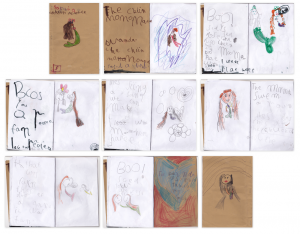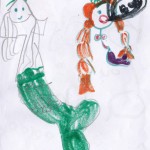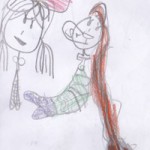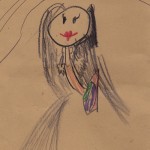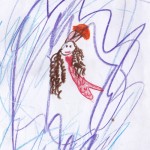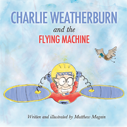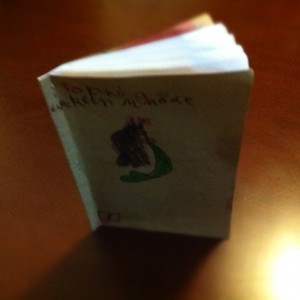 My eldest daughter is in her first year of school this year, and surprised us today with this absolute gem: her very first book, created during the personal work time allocated to her over the last few weeks (students can work on whatever they want during this time).
My eldest daughter is in her first year of school this year, and surprised us today with this absolute gem: her very first book, created during the personal work time allocated to her over the last few weeks (students can work on whatever they want during this time).
I promise I won’t fill this blog with posts where I rave about how amazing my own children are (although, they really are, you know). But I had to share it because I find her phonetic spelling absolutely fascinating. I’ve reproduced the unedited version here (with her permission) as well as a corrected version below (she proudly read it to her sister at bedtime tonight, so I’m confident that I’ve captured it correctly). See how much you can infer from the first version before you jump to the translation:
The Ckween Momade
by Sophia
The ckiin momomade wanda. the ckiin momomade swimd a rand.
Boo! sed dase doo you wot too plae with mee.
Ys sed the ckeen mooma i weel plae wees you.
Bcos you a reelee fan I lic you reelee fan.
Thes siing a soing we can make the maamas hapee.
The mirmads swem a roune thes des thes doo the chu chu! and the twisD.
that wos farn thes doo et a gane it was fan.
BOO! sced you we best fres.
The and
Book by Sophia
Tahlia my best fens
Here’s the complete story again, this time with corrected spelling …
The Queen Mermaid
by Sophia
The queen mermaid wandered. The queen mermaid swam around.
“Boo!” said Daisy. “Do you want to play with me?”
“Yes,” said the queen mermaid. “I will play with you.”
“Because you are really fun. I like you, (you’re) really fun.”
“Let’s sing a song. We can make the mermaids happy.”
The mermaids swam around. “Let’s dance! Let’s do the cha-cha! And the twist!”
“That was fun. Let’s do it again. It was fun.”
“Boo! Scared you! We’re best friends.”
The end.
Book by Sophia
(P.S. Tahlia is my best friend)
I love that the teacher hasn’t corrected her spelling for this project (that will be a separate exercise, no doubt). It’s a conscious decision by the staff to encourage the students to “be brave” when it comes to writing (which I learned from one of the excellent literacy information evenings that the teachers put on for parents). It can be a daunting prospect to put pen to paper (even for adults!); taking away the fear of obtaining perfect spelling frees up their creativity to create gems like this.
I also love that the story has a definite structure—a beginning, a middle, and an end. On top of that, there is a twist, which shows she understands the need for there to be some tension (even if it’s just a “Boo!” from the protagonist). Of course, I won’t pretend to be unbiased here!
This blows my mind—not only because our daughter is not even 5 and a half yet, but when contrasted to February of this year when school started, the progression is just phenomenal (the teachers tell me that the acceleration in learning during the second half of the year is even more so!)
Perhaps I’ll have some competition in the marketplace once my book becomes available (any day now, really!). At any rate, the prospect that creating stories might run in the family makes me a very proud dad.

